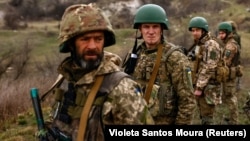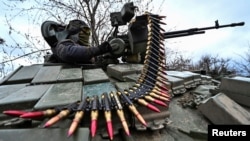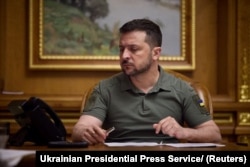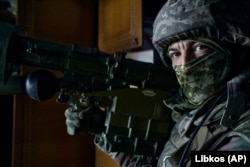Last fall, Ukraine rewrote the story of Russia’s invasion. It wasn’t the first time, and if things go as well in the coming weeks as Ukraine prays they will, it won’t be the last.
On October 1, 2022, Russia pulled out of the Donetsk region town of Lyman, ceding the town to Ukrainian forces and marking the culmination of a two-month counteroffensive that recaptured dozens of settlements mainly in the Kharkiv region, and highlighted major operational problems with Russia’s military. The success stunned Russia and surprised many Western observers.
Now, after a grinding winter in which Russia struggled to regain battlefield momentum, both Moscow and Kyiv are girding for a new counteroffensive that Ukrainian officials have signaled is imminent. One way or another, it will be major turning point in the invasion.
It’s unclear when it will begin.
Ukraine’s notorious late spring mud season, which makes swaths of fields and forests impassable even to tracked vehicles, may be the biggest determining factor.
But what is clear, according to Western assessments, is that the offensive will be larger and more complicated than any other effort Ukraine has conducted since the launch of the Russian invasion on February 24, 2022. For that reason alone, Kyiv’s Western backers are offering guarded predictions.
“If you see the reality on the ground, we have a military stalemate situation and a war of attrition. This offensive, which will probably take place after the ‘mud period,’ is necessary from a political point of view and also militarily,” said Erich Vad, a retired German Army brigadier general and former military advisor to Chancellor Angela Merkel. “But in the end, it’s unlikely that the offensive will change the overall military situation because of the pure numerical superiority of Russia and its escalation dominance.
“Maybe the Ukrainians will surprise us,” he told RFE/RL. “They have surprised us since the beginning. No one believed they could fight against the Russian superiority for a year.”
“The Ukrainians are naturally impatient to get on with the business of pushing the Russians out of their country,” Lawrence Freedman, an emeritus professor of war studies at King’s College London, said in an analysis published on April 16. “But now that spring has come, there are doubts about whether they are truly ready for a big push against the Russian occupiers.”
Ukraine’s forces are newly equipped, newly armed, and newly reconstituted, with as many as 12 newly formed brigades, three-quarters of which have been working with NATO and U.S. trainers in a complicated tactic known as combined arms maneuvers. It’s a concept that calls for simultaneously using different types of weaponry and units -- artillery, aircraft, infantry, tanks, engineering -- in a coordinated, “symphony-like” manner . It’s a new concept for Ukrainian officers, many of whom were brought up with Soviet-legacy thinking.
Ukraine’s newest units, plus all of its regular and irregular units, will go into their offensive with more than $32 billion in weapons and security assistance from U.S. arsenals, plus billions more from European allies.
U.S. supplies include high-profile weaponry like Stryker and Bradley armored vehicles, Cougar mine-resistant infantry vehicles, and HIMARS, a long-range rocket launch system that Ukrainian troops used to great effect in their Kharkiv counteroffensive. U.S.-made Patriot missile batteries have arrived in Ukraine and some are already in use, according to Ukrainian Air Force spokesman Yuriy Ihnat. Abrams M1 battle tanks are not expected to arrive in time for the spring counteroffensive.
Other marquee weaponry that Ukrainian units are expected to field include German Leopard 2 tanks, British Challenger tanks, and French AMX-10 vehicles.
The top U.S. commander for European forces, General Christopher Cavoli, told U.S. lawmakers on April 26 that “98 percent” of the combat vehicles pledged by NATO allies to Ukraine had already been delivered.
“I’m optimistic that between this year and next year, I think Ukraine will continue to have the momentum with it,” British Defense Secretary Ben Wallace told reporters in Washington last week. “I also think we should be realistic. There is not going to be a single magic-wand moment when Russia collapses.”
But Ukraine is lacking in other crucial equipment: less glamorous items such as tractor-like vehicles to clear paths through minefields so infantry can advance, or vehicles that can quickly place a temporary bridge over a waterway.
Then there’s the simple fact that Russia has been digging in and expanding its defensive lines -- minefields, trenches, anti-tank “dragon’s teeth” -- across the roughly 1,200-kilometer front that stretches from Ukraine’s Luhansk region, in the Donbas, southwest to the mouth of the Dnieper River and its eastern banks in the Kherson region. And Russia has shorter supply lines than Ukraine.
“The Russians still have numerical advantage, and they have the escalation dominance on the battlefield,” Vad said. “And they are now in a very strong defensive position. And if you want to attack, you need at least three- to five-times superiority on the ground.”
“There should be no doubt about the complexity of such operations,” Mick Ryan, a retired Australian Army major general, wrote in a blog post earlier this month. “Indeed, there is no military endeavor that is more difficult to plan, orchestrate, and execute than combined arms obstacle breaching.”
'Modest Territorial Gains'
For obvious reasons, exactly where and when Ukraine intends to attack is a closely guarded secret. That’s been complicated further by the damaging leaks of classified Pentagon documents that appeared earlier this year on a Discord server popular with gamers.
Among the revelations, the White House has doubts about how successful the Ukrainian effort will be, with the likelihood that it will yield only “modest territorial gains.”
Many Western observers and military experts have pointed to the Zaporizhzhya region, about 550 kilometers southeast of Kyiv, as one likely possibility for the assault. A successful drive southward, to the city of Melitopol or the port of Berdyansk, would threaten the “land bridge” -- the corridor that Russia has used to supply its troops to the west, in the Kherson region, and, more importantly, in Crimea, the Ukrainian peninsula that’s been under Russian occupation since 2014.
The portion of the Kherson region on the Dnieper’s east bank -- where Russian forces withdrew in November, ceding the provincial capital after weeks of relentless pressure from Ukrainian troops -- is another possibility. From their positions across the river, Russia has continued to shell and rocket the city of Kherson, on the opposite bank, terrorizing residents. There are conflicting reports whether Ukrainian special force units have established a bridgehead across, and upriver, from the city.
Other possibilities include locations in the Donetsk or Luhansk regions, such as Vuhledar, where Russian forces have suffered several devastating defeats in recent months.
'Grind Down The Ukrainians, Grind Down The United States And European Allies'
Ukraine’s need for a tangible battlefield success stems partly from the fact that, notwithstanding Russia’s failed winter offensive, the overall invasion, now in its 15th month, has turned into a war of attrition.
Western defense and intelligence estimates of Russian casualties number around 200,000 killed or wounded. Ukraine’s figures are harder to come by, though the leaked Pentagon documents -- and Western officials speaking anonymously -- have put Ukraine’s casualties in excess of 120,000 killed or wounded.
Both sides have sought to bolster their troop strength. The mobilization that Russia launched last September netted as many as 300,000 additional troops, though not all have been deployed to Ukraine. The private mercenary group Wagner has sent tens of thousands of soldiers into battle; the majority have been prison inmates recruited since last summer.
Russia is also conducting a new recruitment campaign, while also modernizing its mobilization system and cracking down on draft dodgers. It’s unclear how many more troops the effort will yield, though Russian officials have signaled hopes for up to 400,000 more.
Many of Ukraine’s forces are believed to be exhausted and some units badly depleted. Ukraine has had a national mobilization in place since the Russian invasion, has created a network of new assault brigades called the Offensive Guard, under the Interior Ministry, and has sought to bolster its more highly trained regular units with NATO-trained troops.
“In total, we have trained and equipped more than nine new Ukrainian armored brigades. This will put Ukraine in the strong position to continue to retake occupied territory," NATO Secretary-General Jens Stoltenberg said on April 27.
Attrition favors Russia, with its larger population, its larger industrial base, and more natural resources -- factors that make sustained Western support, which can help narrow or reverse that advantage, all the more crucial. President Vladimir Putin has made it all but clear that he thinks he has the time and resources to outlast Ukraine and its Western backers.
Putin “still believes today that he can make time work for him…that he can grind down the Ukrainians, that he can grind down the United States and our European allies, and that ultimately Ukraine matters more to him than to us,” CIA Director William Burns said in a talk at Texas A&M University earlier this month.
“But the Ukrainians are quite determined. And I’ve learned over the course of the last couple years not to underestimate their drive or their capability,” Burns said.
Meanwhile, with the new offensive still pending, Ukraine may make further efforts to strengthen its hand, Vad said.
“The longer the Ukrainians wait for their offensive, the better they can push the Western allies to give them more equipment, tanks, and so on,” he said.
'They Must Show They Are Effective'
But attrition may also favor Russia because of growing impatience among Ukraine’s Western backers, some of whom, like France, are actively pushing for some sort of cease-fire or peace negotiations.
In the United States, public opinion polls show waning enthusiasm for arming Ukraine, and a small but growing number of lawmakers in the Republican Party are angling for a slowdown, if not a halt, to U.S. military largesse.
“From a political point of view, the offensive is important to show the Western allies that the Ukrainian forces are operational, that they are capable of pushing back the Russians from these Ukrainian oblasts and to change the military situation,” Vad said.
Ukrainian civilian and military leaders have publicly signaled that the ultimate aspiration is to recapture all Ukrainian land now under Russian control.
“Victory for the Ukrainians seems to be at the moment the liberation of all their territory, including Crimea,” David Silbey, a military historian at Cornell University, told RFE/RL. “Given [President Volodymyr] Zelenskiy’s rhetoric, it would be hard for him to sell the Ukrainian people on much less at this point."
For now, few outside observers consider that realistic. And if Ukraine is unable to make major territorial gains or inflict devastating losses on Russian troops, Western leaders are likely to push Zelenskiy's government to be open to negotiations with Moscow.
“What Ukraine needs is peace, not a protracted war of attrition against a more populous adversary whose leader does not much care about how many lives are sacrificed in the maelstrom,” Stephen Walt, a professor of international relations at Harvard University, wrote earlier this month.
The prospect of making concessions with Russia still holding large swathes of territory adds to the pressure on Ukraine to mount a successful counteroffensive.
“Not only do [the Ukrainians] need to demonstrate decisive victories over the Russians, they must show they are effective users of all the military assistance provided in the past six months or so,” Ryan wrote.
“The fickle politics and publics in Western nations have become less engaged in the war’s progress,” he wrote. “The Ukrainians understand that the offensives to come must once again show the people of the West that not only is Ukraine worth supporting, but with ongoing military assistance in 2023 and beyond, they can defeat the Russian invasion.”












